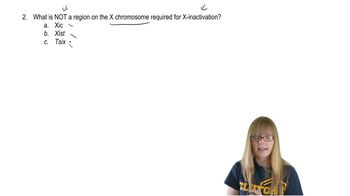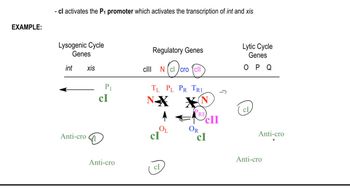Table of contents
- 1. Introduction to Genetics51m
- 2. Mendel's Laws of Inheritance3h 37m
- 3. Extensions to Mendelian Inheritance2h 41m
- 4. Genetic Mapping and Linkage2h 28m
- 5. Genetics of Bacteria and Viruses1h 21m
- 6. Chromosomal Variation1h 48m
- 7. DNA and Chromosome Structure56m
- 8. DNA Replication1h 10m
- 9. Mitosis and Meiosis1h 34m
- 10. Transcription1h 0m
- 11. Translation58m
- 12. Gene Regulation in Prokaryotes1h 19m
- 13. Gene Regulation in Eukaryotes44m
- 14. Genetic Control of Development44m
- 15. Genomes and Genomics1h 50m
- 16. Transposable Elements47m
- 17. Mutation, Repair, and Recombination1h 6m
- 18. Molecular Genetic Tools19m
- 19. Cancer Genetics29m
- 20. Quantitative Genetics1h 26m
- 21. Population Genetics50m
- 22. Evolutionary Genetics29m
12. Gene Regulation in Prokaryotes
Lambda Bacteriophage and Life Cycle Regulation
Problem 26b
Textbook Question
Suppose that base substitution mutations sufficient to eliminate the function of the operator regions listed below were to occur. For each case, describe how transcription or life cycle would be affected. OR3 mutation in λ phage
 Verified step by step guidance
Verified step by step guidance1
Understand the role of the operator region OR3 in the λ phage. OR3 is part of the regulatory region that controls the transcription of genes involved in the lysogenic and lytic cycles.
Recognize that in the λ phage, the OR3 operator is involved in the repression of the lytic cycle. It is bound by the λ repressor protein (CI) to prevent transcription of genes necessary for the lytic cycle.
Consider the effect of a mutation in OR3 that eliminates its function. This would likely prevent the λ repressor from binding effectively to OR3.
Predict that without the λ repressor binding to OR3, the transcription of genes necessary for the lytic cycle would not be repressed, potentially leading to the activation of the lytic cycle.
Conclude that the mutation in OR3 could result in the λ phage favoring the lytic cycle over the lysogenic cycle, as the repression mechanism is compromised.
Recommended similar problem, with video answer:
 Verified Solution
Verified SolutionThis video solution was recommended by our tutors as helpful for the problem above
Video duration:
6mPlay a video:
Was this helpful?
Key Concepts
Here are the essential concepts you must grasp in order to answer the question correctly.
Operator Regions
Operator regions are specific DNA sequences where regulatory proteins bind to control the transcription of adjacent genes. In the context of phage λ, the operator regions play a crucial role in regulating the expression of genes necessary for the phage's life cycle, including those involved in lytic and lysogenic pathways.
Recommended video:
Guided course

Regions of X Chromosomes
Transcription Regulation
Transcription regulation refers to the mechanisms that control the rate and timing of gene expression. In phage λ, the binding of repressor proteins to operator regions prevents transcription of certain genes, thereby influencing whether the phage enters a lytic or lysogenic cycle. Mutations in these regions can disrupt this regulation, leading to uncontrolled gene expression.
Recommended video:
Guided course

Eukaryotic Transcription
Lytic vs. Lysogenic Cycle
The lytic and lysogenic cycles are two distinct pathways that a bacteriophage can follow after infecting a host cell. In the lytic cycle, the phage replicates rapidly, leading to cell lysis and release of new phage particles. In contrast, the lysogenic cycle involves integration of the phage DNA into the host genome, allowing for a dormant state. Mutations affecting operator regions can shift the balance between these cycles, impacting the phage's life cycle and its interaction with the host.
Recommended video:
Guided course

Decision Between Lytic and Lysogenic Cycles

 4:29m
4:29mWatch next
Master Bacteriophage Life Cycle with a bite sized video explanation from Kylia Goodner
Start learning


